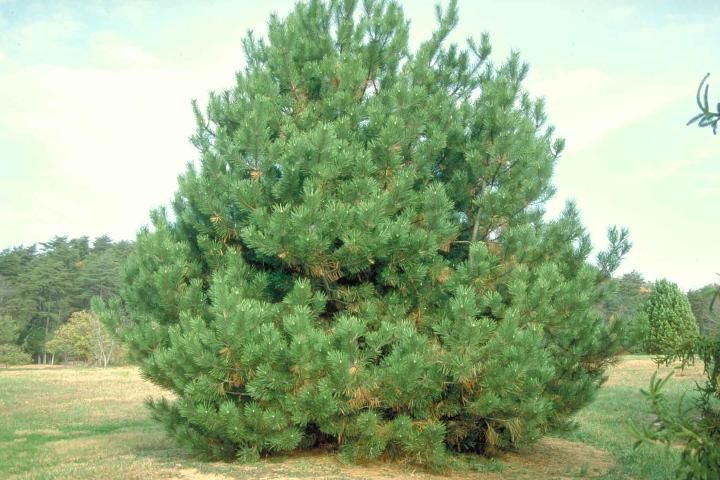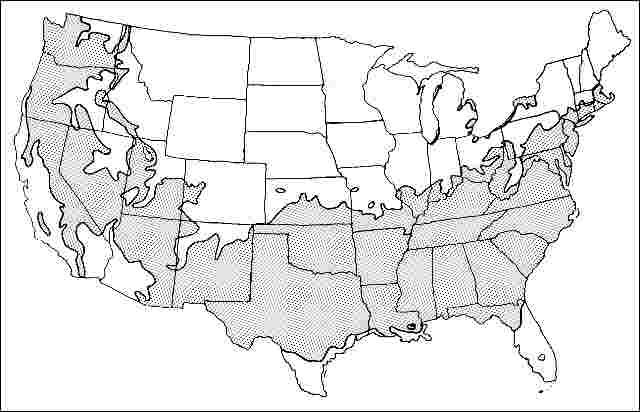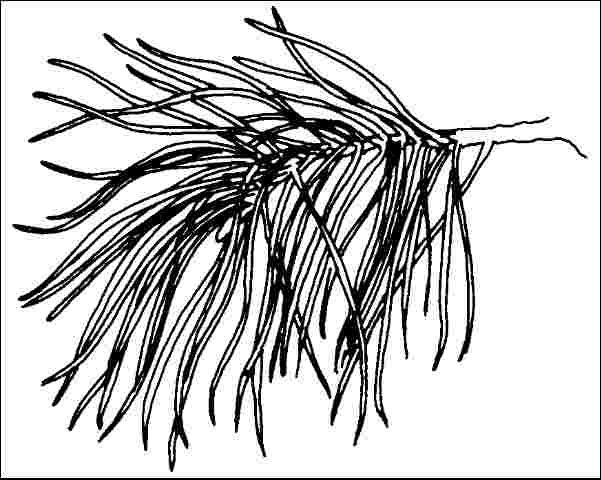Introduction
An excellent, small, irregularly-shaped Pine, the size and shape of Japanese Black Pine is variable reaching a height of 25 feet and a spread of 20 to 35 feet. The exceptionally dark green, five to seven-inch-long twisted needles are borne in groups of two. Although trees may or may not have a central leader prune to develop one if the tree will be grown to a large size. Branches are held horizontally in a picturesque silhouette and sometimes can outgrow the central leader forming an attractive multistemmed specimen tree. It is probably best used in this way.

Credit: Ed Gilman
General Information
Scientific name: Pinus thunbergiana
Pronunciation: PIE-nus thun-ber-jee-AY-nuh
Common name(s): Japanese Black Pine
Family: Pinaceae
USDA hardiness zones: 6A through 8B (Fig. 2)
Origin: not native to North America
Invasive potential: little invasive potential
Uses: specimen; container or planter; Bonsai; highway median
Availability: not native to North America

Description
Height: 25 to 30 feet
Spread: 20 to 35 feet
Crown uniformity: irregular
Crown shape: pyramidal
Crown density: open
Growth rate: moderate
Texture: medium
Foliage
Leaf arrangement: alternate (Fig. 3)
Leaf type: simple
Leaf margin: entire
Leaf shape: needle-like (filiform)
Leaf venation: parallel
Leaf type and persistence: fragrant, evergreen, needled evergreen
Leaf blade length: 2 to 4 inches
Leaf color: green
Fall color: no color change
Fall characteristic: not showy

Flower
Flower color: yellow
Flower characteristics: not showy
Fruit
Fruit shape: oval, cone
Fruit length: 1 to 3 inches
Fruit covering: dry or hard
Fruit color: brown
Fruit characteristics: does not attract wildlife; showy; fruit/leaves a litter problem
Trunk and Branches
Trunk/bark/branches: branches droop; not showy; typically multi-trunked; thorns
Pruning requirement: little required
Breakage: resistant
Current year twig color: brown
Current year twig thickness: medium, thick
Wood specific gravity: unknown
Culture
Light requirement: full sun
Soil tolerances: clay; sand; loam; alkaline; acidic; well-drained
Drought tolerance: high
Aerosol salt tolerance: high
Other
Roots: not a problem
Winter interest: no
Outstanding tree: no
Ozone sensitivity: tolerant
Verticillium wilt susceptibility: resistant
Pest resistance: sensitive to pests/diseases
Use and Management
Trunks are usually not straight but sweep up in a gentle curve. It is often used as a specimen on smaller properties, or is planted in groups on larger scale landscapes. Space 10 to 20 feet apart for mass planting or to create an open screen. Japanese Black Pine can be successfully trained into a bonsai or small specimen plant with selective pruning.
The plant tolerates dry, sandy soil and is extremely salt tolerant, being used successfully along beach front property in the full sun. It also grows well in clay soil with a pH of 8.0. Drought tolerance is good. May grow two to three feet in a year but this rapid growth under optimum cultural conditions may lead to the asymmetrical, open growth habit.
Propagation is by seed which germinate readily.
Pests
Usually none serious, except Pine wilt nematode in the east and tip moth on recently transplanted Pines.
The Maskell scale has recently devastated large numbers of trees in New Jersey.
Some adelgids will appear as white cottony growths on the bark. All types produce honeydew which may support sooty mold. European Pine shoot moth causes young shoots to fall over. Infested shoots may exude resin. The insects can be found in the shoots during May. Pesticides are only effective when caterpillars are moving from overwintering sites to new shoots. This occurs in mid to late April or when needle growth is about half developed.
Bark beetles bore into trunks making small holes scattered up and down the trunk. The holes look like shotholes. Stressed trees are more susceptible to attack. Keep trees healthy.
Sawfly larvae caterpillars are variously colored but generally feed in groups on the needles. Some sawfly larvae will flex or rear back in unison when disturbed. Sawflies can cause rapid defoliation of branches if left unchecked.
Pine needle miner larvae feed inside needles causing them to turn yellow and dry up.
Pine needle scale is a white, elongated scale found on the needles. Pine tortoise scale is brown and found on twigs. Depending on the scale, horticultural oil may control overwintering stages.
Pine spittle bug lives and hides in a foamy mass.
Zimmerman Pine moth larvae bore into the trunk. The only outward symptoms may be death of parts of the tree or masses of hardened pitch on the branches.
The larvae of Pine weevils feed on the sapwood of the leaders. The leader is killed and the shoots replacing it are distorted. First symptoms are pearl white drops of resin on the leaders. The leaders die when the shoot is girdled as adults emerge in summer.
Diseases
This pine is resistant to Diplodia tip blight.